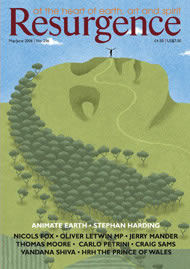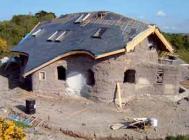A RECENT REPORT argued that food can only be called sustainable if it is consumed within a twenty-mile radius of where it is grown, organic or not. The concept of food miles is generally accepted now, but for most of us it applies no further than food. While green building from the point of energy efficiency is becoming more commonplace, we need to consider the issue of building miles. We need to ask, how far have building materials travelled?
Food and building miles are only possible because of an abundance of cheap fossil fuels, which will soon come to an end. At some point in the next decade world oil production will peak, and we will enter a period of continuous decline, when the price of oil will rapidly rise and supplies will decrease – a phenomenon known as ‘peak oil’. The implications for our society are profound, with little indigenous manufacturing, and increasing dependence on China for everything from computers to toothbrushes. Moreover, even if there were no shortage of oil, its constant use produces climate change and global warming. Therefore, shortage or no shortage, the reliance on oil for transportation of goods over long distances is inherently unsustainable.
Embodied energy
Some argue that there is no point in considering embodied energy – the energy it takes to source, process, manufacture, store and transport a material – in new building codes, as the amount of energy that goes into a house is only between 5% and 20% of the energy it will consume during its lifetime. This percentage depends on how energy-efficient the house is: the more energy-efficient we make a house, the more consideration we need to give to materials. Many of the most efficient buildings, such as the German Passivhaus, use large amounts of high-embodied-energy materials such as concrete. If we wish our new construction to be truly ecological then we cannot ignore the question of where our materials come from.
Many so-called green building materials have high levels of dependence on the globalised economy, such as sheep’s-wool insulation that is sheared in Australia, flown to Germany to be processed, and then trucked to the UK. Even ‘ecological’ insulation fibreboards, clay plasters and ecological paints have to be imported from Germany. You can now buy whole houses, made from timber, manufactured in Estonia and Latvia, and imported to the UK as kits. Such houses may give an appearance of being ‘green’ but in reality they contain a hidden energy subsidy which will very soon make them prohibitively expensive at best, and at worst unobtainable.
Local materials
As with food, so with buildings: we need to move towards the local. Until the 1930s we had vibrant local industries in the UK producing timber, tiles, bricks, windows, lime and stone. Our historical dependence on locality for building materials gave rise to distinctive regional styles, as documented in Alec Clifton-Taylor’s seminal book The Pattern of English Building. In today’s globalised economy our materials come from whichever country can produce them the most cheaply. We are importing slate from China and stone from India!
Rising oil prices will necessitate a move towards relocalisation, which will affect all areas of our lives – not just food and building. As economist David Fleming writes, “localisation stands, at best, at the limits of practical possibility, but it has the decisive argument in its favour that there will be no alternative.”
Constructing with building miles in mind
Two recent building projects provide the model for the new approach to building miles. First, the home I built in West Cork, Ireland, which contained no cement (a highly energy-intensive building material) and was built to be highly energy-efficient. Local materials were chosen wherever possible, then recycled ones, and lastly natural ones. From the local stone foundations to the three-foot-thick cob walls, and from window frames made from our own trees to the handmade clay plasters, most materials were sourced locally.
The house is beautiful and cosy. At the end of the process we proved that it is possible to build a house using mainly local materials. Cob walls do not reach the levels of energy efficiency of, say, the Passivhaus, but they have a far lower embodied energy and are far more attractive and healthy to be in. What we are seeking in natural building is the best of the old and the best of the new: modern design and thermal modelling to minimise ongoing CO2 emissions, combined with the use of natural and local materials in their most appropriate applications.
More recently, at Kinsale Further Education College in Ireland, we built the Kinsale Playhouse, an amphitheatre performance space. The building was based on the idea of using entirely local materials that could be handled by unskilled students rather than professionals. We used the cordwood technique for the walls, using cob as the mortar. The only things in the building that didn’t come from within about ten miles were the nails and the lime (both of which are possible to manufacture locally).
The finished building is both a useful space and a work of art, embellished with relief sculptures and gargoyle heads made by the students. It is sculptural, elegant and functional. It is a magical venue for plays and concerts much admired in the town.
Designing from the ground up
What is important about both these projects is that materials were considered from the beginning. As when cooking food we should design meals around what is available locally and what is in season. Similarly, the first step in designing buildings should be identifying what materials are available locally. This then guides the whole design process.
Retrofitting
One of the biggest challenges for a post-peak-oil contracting economy will be how to retrofit the houses already built. How will that be possible when we no longer have access to industrial building materials? Hemp, lime, clay and straw would appear to be among the most promising materials. If we are to retrofit the UK’s 25 million homes using indigenous materials we will require a profound rethink of the materials we use and how we use them.
The need for beauty
We need beauty as much as we need energy efficiency. Houses we can sculpt and form with our hands, houses with secret spaces and niches in the walls, houses that feel as though they have always been there and probably always will. We can have healthy, breathing and energy-efficient homes that require no space heating, we can create vibrant local markets and more diverse forms of land use, and we can reintroduce a sense of beauty and an elegant simplicity to our buildings which many people believe went out with the mangle.
A resurgence of local building materials will lead to a cultural renaissance. The rethinking of how we will house ourselves in an ecologically sustainable way is a huge task, but as with all aspects of rethinking our economy and communities beyond oil, it is our great opportunity to build the world we actually want: one which could be far, far preferable to the present.
For more information visit








